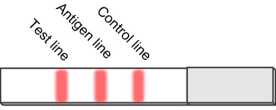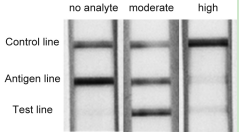The hook effect or the prozone effect is a kind of interference induced by high concentrations of the analytes in sandwich immunoassays. When the concentration of the analyte is very high, the analyte will saturate the detection antibody and capturing antibody respectively. This inhibit or even block the formation of the sandwich structure and lead to a false negative or inaccurately low results.
Now, we CDIATM Test provide a new strategy by introducing an antigen line into the conventional colloidal gold immunoassay strip to overcome this limitation of the detection range.

The basic model of the new strategy is shown as above, the antigen line is added between the control line and the test line. To put it simple, the antigen line detects the free colloidal gold-conjugated antibodies which bind no analytes. Thus, in 0 or low concentrations, it function partially like a control line; but if the colloidal gold-conjugated antibodies are totally or largely occupied by the analytes from the sample, the antigen will show no or much weaker signal.

This strategy provides us an easy way to distinguish high concentration with the negative result, and furthermore, with proper devices and algorithm, a calibration curve can be created for quantitative calculation.
If you have any ideas or questions related to the antigen line strategy, please feel free to contact us, we would be honored to communicate with you on this technique. What's more, Strep A Antigen Test Kit can give quantitative results for rapid test strips.
References
Oh Y K, Joung H A, Han H S, et al. A three-line lateral flow assay strip for the measurement of C-reactive protein covering a broad physiological concentration range in human sera[J]. Biosensors and Bioelectronics, 2014, 61: 285-289.
Related reading: Streptococcus A Group rapid test C. trachomatis Rapid Test
